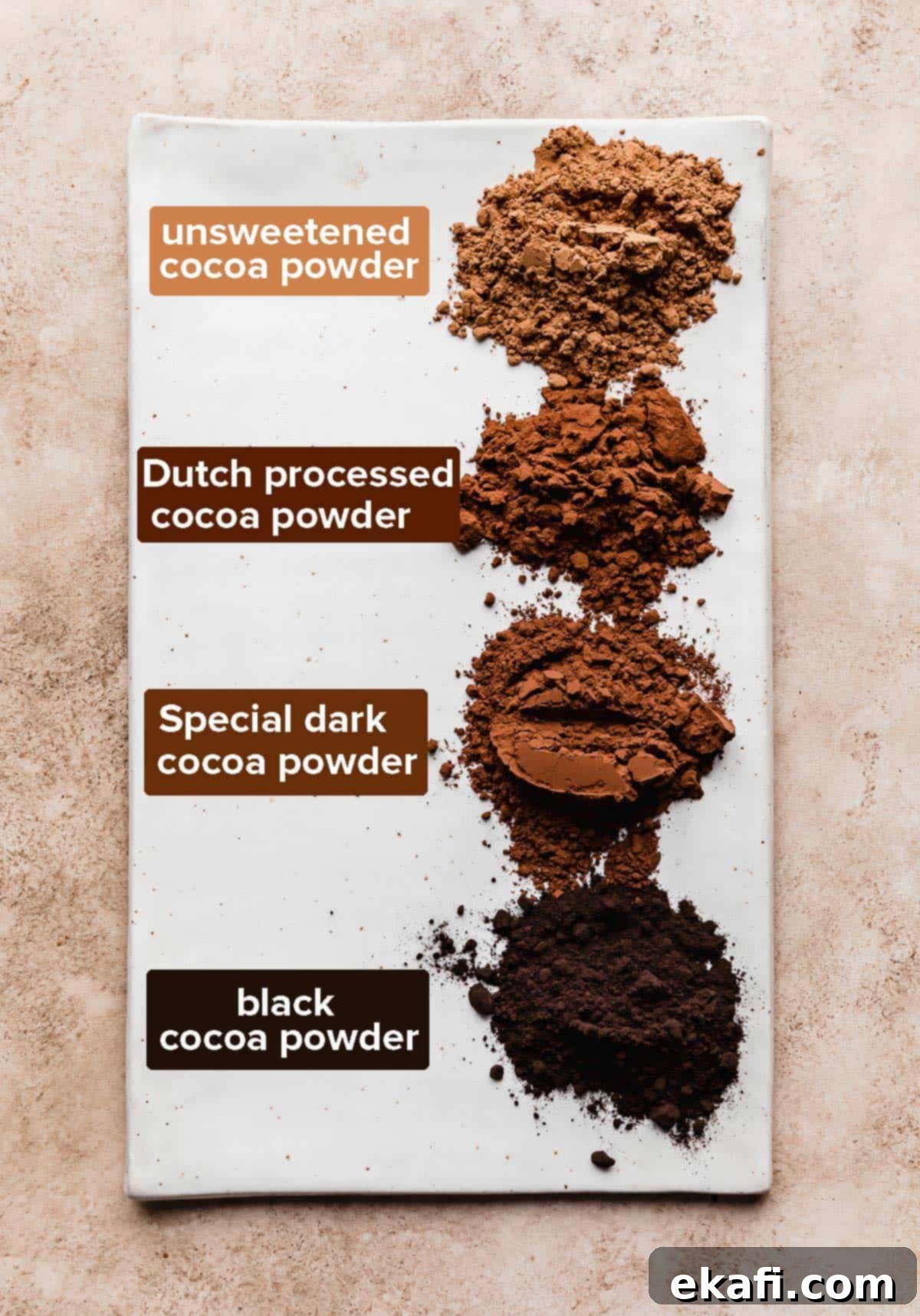The Ultimate Guide to Cocoa Powder: Unsweetened, Dutch Process, & Black Cocoa Explained
Baking is both an art and a science, and understanding your ingredients is key to achieving perfect results every time. When it comes to chocolate-infused delights, one ingredient often causes confusion: cocoa powder. Knowing the distinct differences between unsweetened cocoa powder, natural cocoa powder, Dutch process cocoa powder, and black cocoa powder can dramatically elevate your baking!
Most everyday recipes you encounter likely call for unsweetened natural cocoa powder – a staple in classics like my Moist Chocolate Cake Recipe. But why do some recipes specify a different type? And more importantly, why does it matter so much? The type of cocoa powder you choose can profoundly impact your baked goods’ flavor, color, and even how they rise. Let’s delve into the fascinating world of cocoa powder types and uncover their unique characteristics.
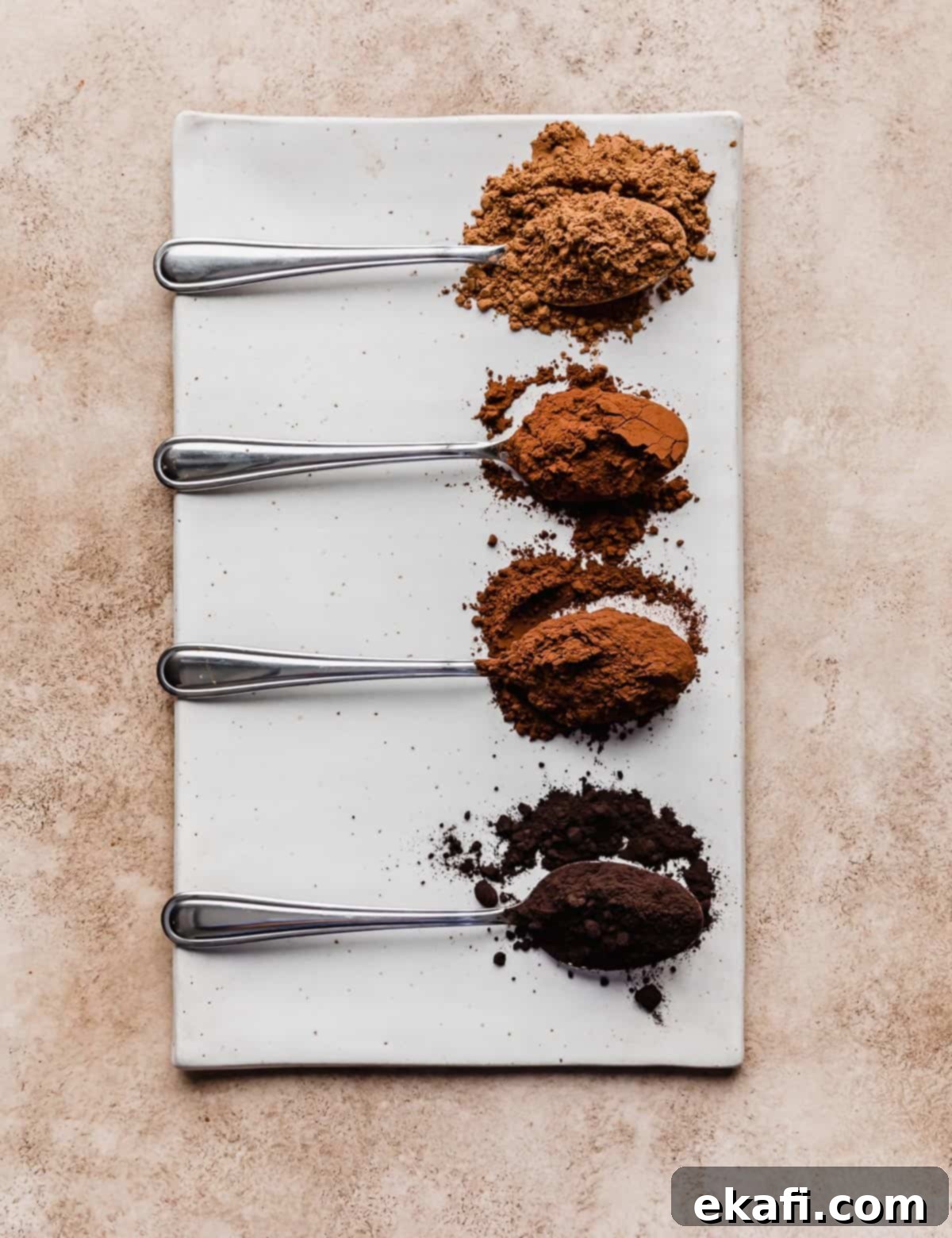
What is Cocoa Powder? The Essence of Chocolate Flavor
Before diving into the varieties, let’s establish a foundational understanding: what exactly is cocoa powder? Cocoa powder is a highly concentrated, unsweetened powder prized for its deep chocolate flavor. It’s an essential ingredient that lends rich taste and color to a myriad of baked goods, including brownies, cookies, cakes, and various other dessert recipes.
The journey of cocoa powder begins with cocoa beans, which are the seeds of the cacao tree. These beans undergo a meticulous process that includes fermentation, roasting, and pressing. During the pressing stage, approximately 75% of the cocoa butter (the fat component) is extracted. What remains is a dense, pasty substance known as chocolate liquor. This liquor is then dried and finely ground to produce the cocoa powder we use in our kitchens. This process leaves behind a product rich in flavor but very low in fat, making it distinct from solid chocolate.
Understanding Unsweetened / Natural Cocoa Powder
It’s important to clarify from the start: unsweetened cocoa powder and natural cocoa powder are the same thing. You might also hear it referred to as baking cocoa. These terms are used interchangeably to describe the most common type of cocoa powder found in American supermarkets. It’s the standard for many classic chocolate recipes.
Let’s break down the key characteristics that define unsweetened natural cocoa powder:
- Origin and Processing: Like all cocoa powders, it comes from cocoa beans. The “unsweetened” and “natural” designation simply means that after the cocoa butter has been largely removed, no alkaline agents or sweeteners are added.
- Acidity: Unsweetened cocoa powder is naturally acidic, with a pH typically between 5.3 and 5.8. This acidity is a crucial factor in how it interacts with other ingredients in baking.
- Leavening Agent Pairing: Due to its acidic nature, unsweetened cocoa powder is almost always paired with baking soda (sodium bicarbonate) in recipes. Baking soda is a base, and when it reacts with an acid (like the cocoa powder) and a liquid, it produces carbon dioxide gas. This gas creates bubbles, causing baked goods to rise and become light and airy.
- Flavor Profile: Its acidity contributes to a sharp, robust, and often slightly fruity chocolate flavor. It delivers a direct, intense chocolate hit.
- Color: Natural cocoa powder is lighter in color, typically a reddish-brown hue. The final baked product will reflect this lighter shade, offering a classic chocolate appearance.
Remember this crucial pairing: Unsweetened/Natural Cocoa Powder = Baking Soda. The chemical reaction is essential for proper leavening and to balance the cocoa’s inherent acidity, preventing an overly tart or metallic taste in your final product.
Popular Recipes Using Unsweetened Natural Cocoa Powder
Many beloved chocolate desserts rely on the acidic kick and classic flavor of unsweetened cocoa powder. Here are a few examples:
- Best Chocolate Cupcake Recipe
- Chocolate Peanut Butter Chip Cookies
- Chocolate Doughnuts
- Homemade Cosmic Brownies
- Double Chocolate Chip Cookies
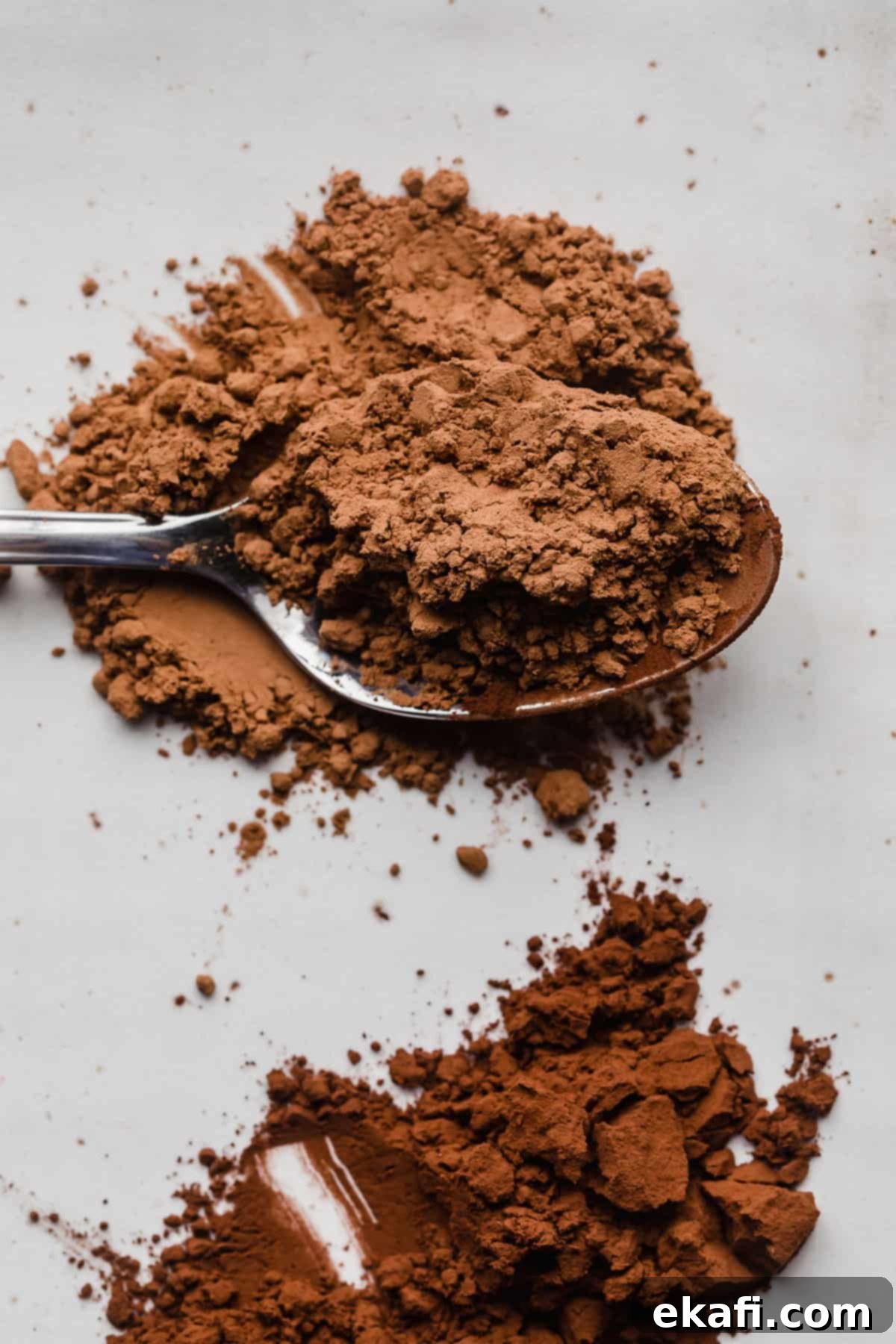
What is Dutch Processed Cocoa Powder?
Dutch process cocoa powder stands in contrast to natural cocoa powder primarily because of how it is treated. It is essentially unsweetened cocoa powder that has undergone a process called “dutching” or alkalization. This involves treating the cocoa with an alkaline solution, such as potassium carbonate, to reduce its natural acidity. You might also see it labeled as “alkalized,” “European style,” or simply “dutched” cocoa.
The alkalization process significantly changes several characteristics of the cocoa powder:
- Acidity (or lack thereof): Dutch process cocoa powder is neutral, or very nearly so, with a pH typically between 6.8 and 8.0. This neutrality is its defining characteristic and dictates its use in baking.
- Leavening Agent Pairing: Since it lacks acidity, Dutch process cocoa powder cannot react with baking soda to produce carbon dioxide. Therefore, it is usually paired with baking powder, or used in recipes where baking powder is the predominant leavening agent. Baking powder contains both an acid and a base (often cream of tartar and baking soda) and only requires liquid to activate its leavening power.
- Flavor Profile: The alkalization mellows the cocoa’s flavor, making it less sharp and more smooth, earthy, and often described as having a “classic chocolate” taste. It often imparts a more intense, less complex, chocolatey flavor compared to the fruitier notes of natural cocoa.
- Color: One of the most noticeable differences is its color. Dutch process cocoa powder is significantly darker, ranging from a rich dark brown to almost black, depending on the degree of processing. This results in baked goods with a deep, dramatic chocolate color.
Remember this crucial pairing: Dutch Process Cocoa Powder = Baking Powder. In recipes using Dutch process cocoa, the cocoa’s role in leavening is minimal; its primary contributions are color and flavor.
Introducing Black Cocoa Powder
As a special mention, black cocoa powder is a specific type of Dutch-processed cocoa powder. It is heavily Dutched, meaning it has been treated with an alkaline solution for a much longer period or with a stronger solution. This extreme alkalization gives it its characteristic intense, almost jet-black color. Its flavor is unique – often described as milder, less bitter, and sometimes reminiscent of Oreo cookies, due to its deep, roasted notes. It’s primarily used when a strikingly dark color is desired, and often in conjunction with other leavening agents that don’t rely on acidity. For an in-depth exploration, check out my Black Cocoa Powder guide!
Delicious Recipes Using Dutch Process Cocoa Powder
Dutch process cocoa is favored for recipes aiming for a rich, dark color and a smooth, less acidic chocolate flavor. Here are some fantastic recipes that call for it:
- Crumbl Cosmic Brownie Cookies
- Crumbl Better Than Sex Cookies
- Chocolate Cake with Peanut Butter Frosting
- Homemade Fudgy Brownies
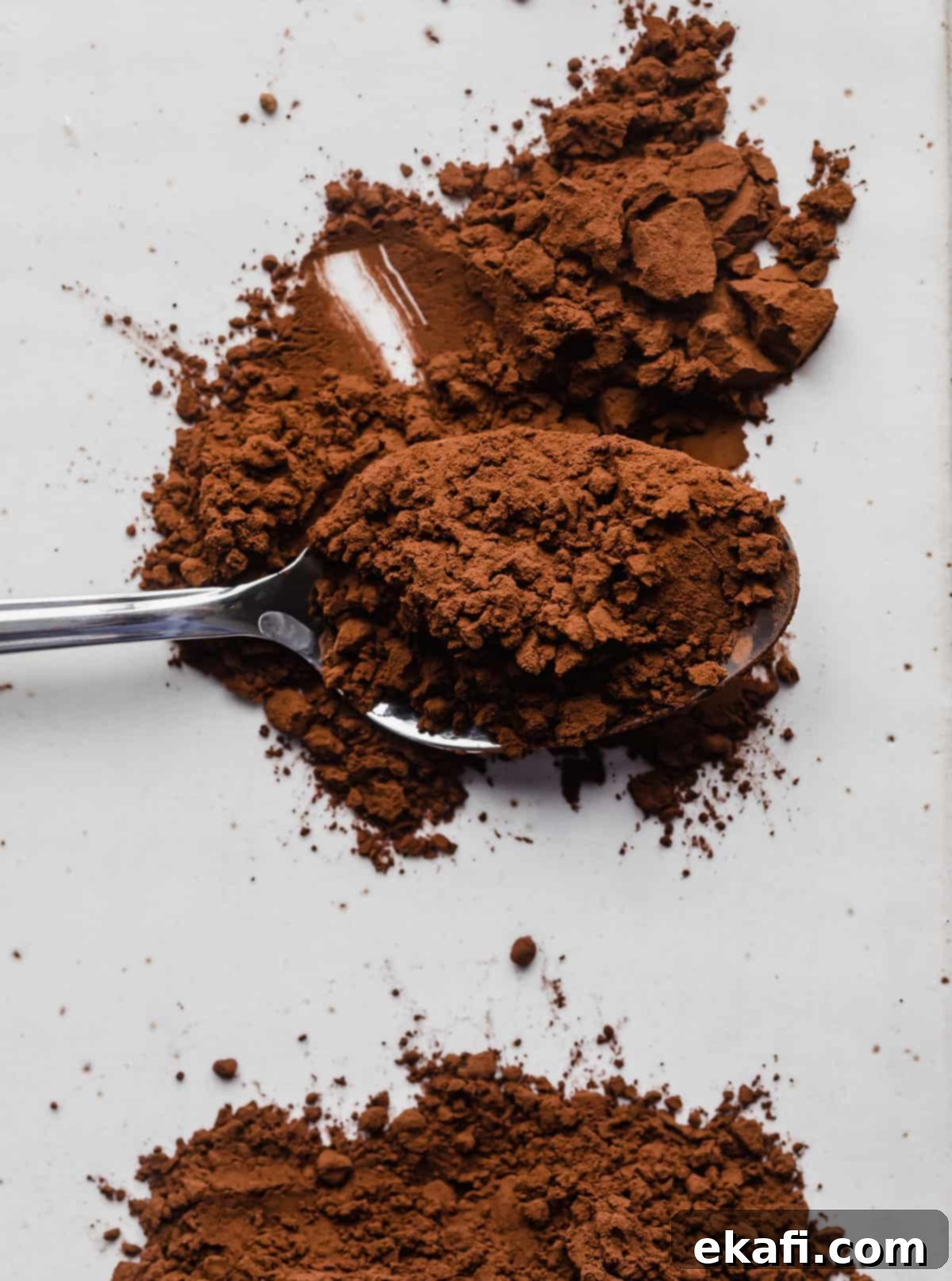
How to Substitute Cocoa Powders Successfully
While a direct 1:1 substitution of cocoa powders might seem straightforward, it’s crucial to understand the potential consequences. When you swap one type of cocoa powder for another, three main aspects of your baked good can be affected: the taste, the rise (leavening), and the color. This is because baking is a science, and the chemical reactions between ingredients are delicately balanced. (Source: King Arthur Baking Company)
Substituting Unsweetened Natural Cocoa Powder for Dutch Process
(Using a 1:1 ratio)
If your recipe calls for Dutch process cocoa powder but you only have unsweetened natural cocoa powder, here’s what you can expect and how to adjust:
- Taste May Be Tangy: Dutch process recipes often use baking powder as the primary leavener, as the cocoa itself is neutral. If you swap in acidic natural cocoa without adding a base, its acidity won’t be neutralized, potentially leading to a sharp, tangy, or slightly metallic flavor in your final product.
- Color Will Be Lighter: Unsweetened natural cocoa powder has a reddish-brown hue, which is lighter than Dutch process cocoa. Consequently, your baked goods will have a less intense, lighter chocolate color.
- Rise Won’t Be Significantly Affected (Usually): Since the original Dutch process recipe likely relies on baking powder for leavening, swapping to natural cocoa usually won’t drastically impact the rise. Baking powder contains its own acid and base and will react with liquid independently of the cocoa powder’s acidity.
How to Adjust Your Recipe: To mitigate the potential tanginess and balance the pH when using unsweetened natural cocoa powder instead of Dutch process, replace the baking powder in the recipe with half the amount of baking soda. This provides the necessary base to react with the natural cocoa’s acidity.
Substituting Dutch Process Cocoa Powder for Unsweetened Natural
(Using a 1:1 ratio)
If your recipe calls for unsweetened natural cocoa powder but you opt to use Dutch process cocoa powder, be aware of these changes:
- Taste May Be “Soapy”: Recipes using natural cocoa powder typically include baking soda to neutralize its acidity. If you substitute with neutral Dutch process cocoa, the baking soda won’t have an acid to react with. This excess, unreacted baking soda can impart an unpleasant, slightly bitter or “soapy” flavor, as noted by King Arthur Baking Company.
- Color Will Be Darker: Dutch process cocoa powder is inherently darker than unsweetened cocoa. Your baked goods will develop a richer, deeper, and more dramatic chocolate color, alongside a milder, less acidic chocolate flavor.
- Rise Will Be Affected: This is the most critical issue. Since the original recipe relies on the reaction between acidic natural cocoa and baking soda for leavening, substituting neutral Dutch process cocoa means there’s no acid to activate the baking soda. This will result in poor rise, leading to dense, flat baked goods.
How to Adjust Your Recipe: To ensure proper leavening when using Dutch process cocoa powder instead of unsweetened natural, replace the baking soda in the recipe with double the amount of baking powder. This provides an independent leavening agent that doesn’t rely on the cocoa’s acidity.
Optimal Storage for Cocoa Powder
Proper storage is essential to maintain the freshness, flavor, and shelf life of your cocoa powder. Store all types of cocoa powder at room temperature in a cool, dark pantry or cupboard. It’s crucial to keep it in a tightly sealed container, such as a Ziplock bag with all air pressed out, an airtight canister, or its original packaging tightly sealed. This prevents moisture and air from degrading its quality and allows it to retain its rich flavor for up to two years.
It’s important to note: Do not freeze cocoa powder. While it might seem like a good way to extend shelf life, freezing can actually be detrimental. Temperature fluctuations and the formation of condensation can introduce moisture into the powder, leading to clumping, flavor degradation, and potentially even mold growth. Stick to cool, dry, and airtight storage for the best results.
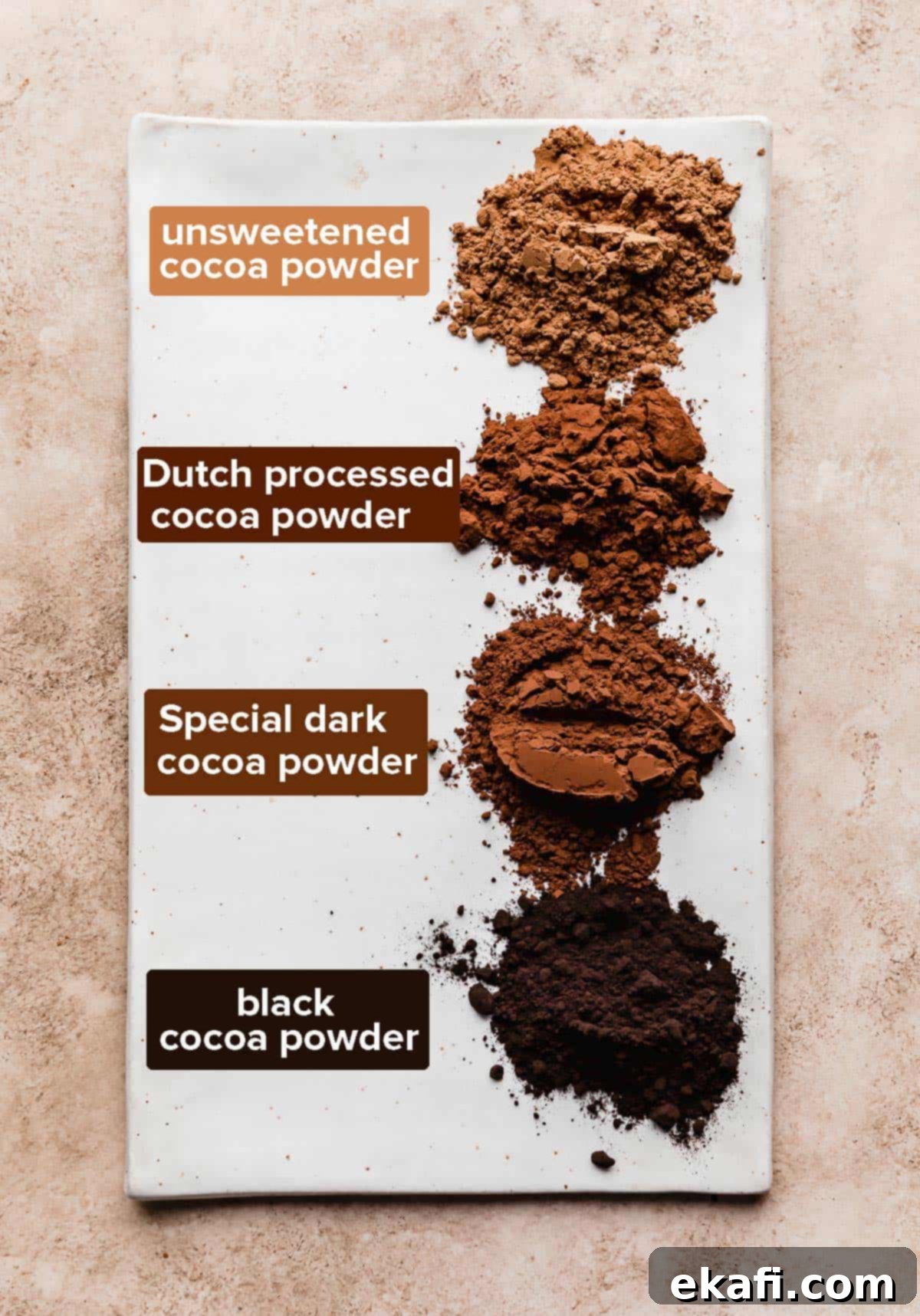
Frequently Asked Questions About Cocoa Powder
Cocoa powder is a dry, unsweetened ingredient derived from cacao beans. After the beans are fermented, roasted, and pressed to remove most of their cocoa butter, the remaining chocolate liquor is dried and ground into a fine powder. Its primary purpose in baking is to provide rich chocolate flavor and color to a variety of desserts.
Yes, absolutely! The terms “unsweetened cocoa powder” and “natural cocoa powder” are used interchangeably to refer to the same product. It signifies cocoa powder that has not undergone any alkalization process and contains no added sugars, making it naturally acidic.
Dutch process cocoa powder is unsweetened cocoa that has been treated with an alkaline solution to neutralize its natural acidity. This process, known as dutching or alkalization, results in a darker-colored cocoa powder with a smoother, less bitter, and often more mellow “chocolatey” flavor profile.
While it is possible to substitute, it’s crucial to understand that doing so without adjustments can significantly impact your recipe’s outcome. The chemical reactions between cocoa powder and leavening agents (baking soda or baking powder) are vital for proper rise, taste, and color. For the best results, always refer to the substitution guidelines provided above, which detail how to adjust your leavening agents to maintain the delicate balance of your recipe.
Several excellent brands offer Dutch process cocoa powder. Some popular choices include Ghirardelli and Rodelle, both known for their quality. Other reputable brands that offer Dutched cocoa powders include Valrhona, Wincrest, and Viddie’s Bakery.
For unsweetened natural cocoa powder, Hershey’s Unsweetened Cocoa Powder is a widely available and reliable choice for many bakers. You also can’t go wrong with Ghirardelli’s unsweetened cocoa powder, which consistently delivers excellent results across their product range.
Hershey’s offers both types of cocoa. Their standard Hershey’s Unsweetened Cocoa Powder is natural and acidic. However, Hershey’s also produces a Special Dark cocoa powder. This product used to be a blend of natural and Dutch-processed cocoa, but recent changes to their recipe mean Hershey’s Special Dark Cocoa Powder is now 100% Dutch processed.
The term “Dutch-processed” is a historical nod to the origins of this method. According to Sciencedirect.com, the alkalization process was invented in the early 19th century by Coenraad Johannes van Houten, a Dutch chocolate maker. He developed the technique of treating cocoa with alkaline salts to reduce its bitterness and acidity, leading to a smoother, darker chocolate product – a revolutionary step in chocolate manufacturing.
Yes, you can, but be prepared for noticeable differences in your final product. As detailed in the substitution section above, the color will be lighter, and the taste might be tangier due to the natural cocoa’s acidity if not properly balanced. More importantly, if the original recipe relied on the neutrality of Dutch process cocoa with baking powder for leavening, substituting acidic natural cocoa might lead to an imbalanced reaction and affect the rise. It’s always best to adjust your leavening agents according to our guide to maintain the delicate chemical balance essential for successful baking.
The “best” cocoa powder for baking isn’t a single type; it’s the one that perfectly suits your recipe’s requirements! The ideal choice depends on the specific flavor profile, color, and texture you desire, and critically, the type of leavening agent (baking soda vs. baking powder) used in your recipe. Understanding the acidity and neutrality of each cocoa type is key to selecting the right one for consistent, delicious results.
While both come from cacao, cocoa powder and hot chocolate powder are quite different. As we’ve extensively covered, cocoa powder is simply pure, unsweetened cacao solids (either natural or Dutch-processed) with most of the fat removed. Hot chocolate powder, on the other hand, is a blend that typically contains cocoa powder along with other ingredients, most notably sugar and often milk powder or other flavorings. It’s formulated to dissolve easily and taste good when mixed with hot liquid, whereas pure cocoa powder is intensely bitter and unsweetened, intended for baking or for adding chocolate flavor where sugar is controlled separately.
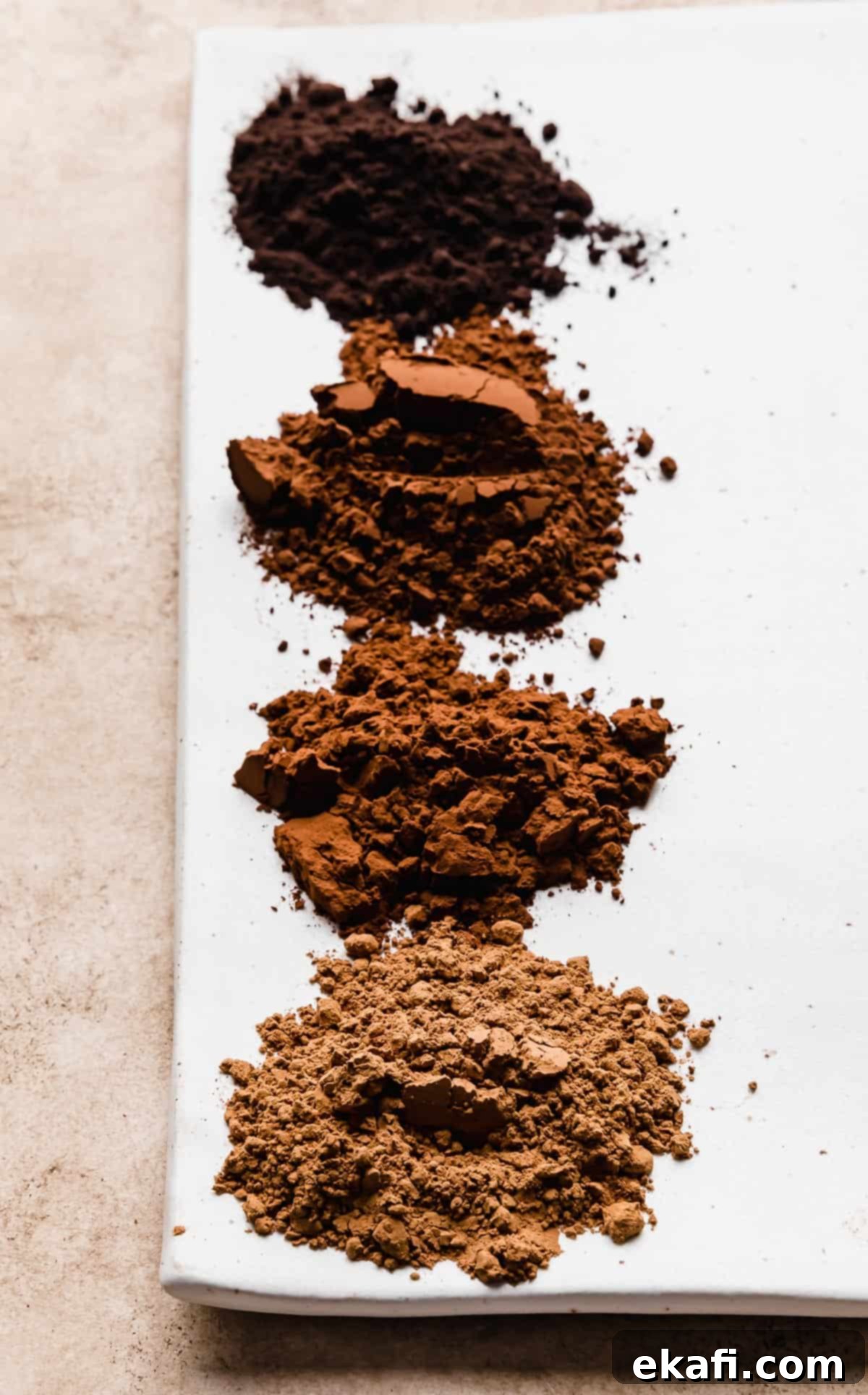
Armed with this knowledge, you can approach your chocolate baking with newfound confidence. Understanding the nuances of each cocoa powder type will empower you to select the perfect ingredient for your desired flavor, color, and texture, leading to consistently superior results. For more invaluable baking tips, explore our extensive guide section.
This comprehensive guide on cocoa powder was compiled with reference to expert resources such as Brown Eyed Baker and King Arthur Baking Company. Their insightful content provides additional details and context for those eager to learn even more.
